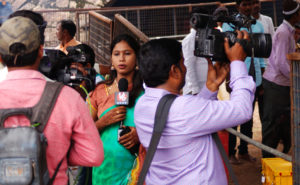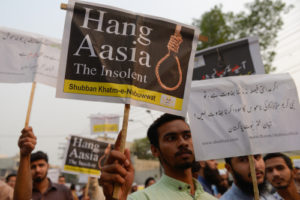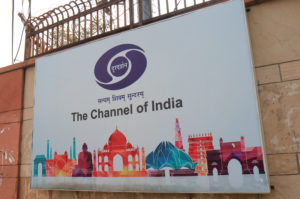William Crawley, Senior Research Fellow
Accusations of ‘fake news’ which target the credibility of responsible media organisations, pale both in the face of the violence and danger to life and limb that journalists in many Asian countries face, and of legal proceedings taken against them by governments or powerful corporations. The limits of the law are often uncertain and challenging them carries a costly risk.
In Myanmar the jailing of two Reuters journalists for investigating alleged army atrocities against the minority Muslim Rohingya community was the product of an ostensibly legal process, though one that – despite Aung San Suu Kyi’s defence of it – has seemed to many of Myanmar’s international partners to have been deeply flawed. The murder of the dissident Saudi journalist Jamal Khashoggi in the Saudi Arabian consulate in Istanbul could have no defence.
In Pakistan the rigours of the law against blasphemy may have been tempered by the release of Asia Bibi, a Christian woman held under sentence of death for eight years. But the assassination of two leading Pakistani politicians who had criticised the law and the widespread protests by conservative Muslims against her release occurred in a climate in which the threat of mob law speaks louder even than the harsh judicial penalties enshrined in the law itself. In Sri Lanka the experience of 30 years of insurgency and emergency rule remained fresh in people’s minds’ even after the extra-judicial killings common on both sides during the civil war were ended.
International civil society organisations such as Reporters without Borders and the Committee to Protect Journalists (CPJ) perform a key role in analysing issues of media freedom16, and monitoring instances where journalists have been threatened or otherwise intimidated, attacked or killed in the course of their work, often while investigating alleged corruption. The CPJ has highlighted three cases in India in the past month:
- the Ambani controlled Reliance Group is suing NDTV for its allegedly misleading reporting of a deal to build French jet fighters in India;
- the case of a local reporter beaten to death in Jharkhand;
- a Doordarshan (Indian State Television) video camera man killed in a Maoist attack in Chhattisgarh.
The killings are supposedly being investigated by the state authorities. But the CPJ’s ‘Impunity Index’ highlights every year fourteen countries with the worst records of impunity, where journalists have been killed and few of the perpetrators brought to justice. India and Pakistan have both been on that list for the past 11 years and Bangladesh for the last eight.
This is the sharp and dangerous edge of media work, and the publication of accurate data is intended to prevent such events occurring in future. But the on-going
challenge is to promote – whether through regulation or self-regulation – an ethical administrative and legal framework in which press and media freedoms can be protected and legitimately enhanced. Like all the world’s media, those in south Asia have undergone a radical transformation in the past 25 years
The explosion of digital social media, instant reporting and 24-hour news have transformed both the economics of the media and perceptions of the media’s core purposes. In south Asia this revolution has been even more extensive with the ending since the mid-1990s of the monopoly of government controlled TV and radio broadcasting. In India the Supreme Court judgement of 1995 declaring the airwaves open to the public was the catalyst, and change in India has been replicated in other countries of the subcontinent.
Competition for advertising from global and private regional language channels, and the drop in revenue for the state broadcasters which continued to depend largely on advertising, compounded the problem. In the position of weakness to which the state broadcasters were reduced, the challenge to the ethos of public service broadcasting, which the state broadcasters claimed to fulfil, became greater. The argument for operational autonomy which many of the state broadcasters had vigorously supported ceased to be so persuasive, as national governments claimed the right to have their own voice in a market where commercial channels have come to dominate the field. In India official guidelines on uplinking commercial TV services were cautiously liberalised over ten years after 2000, and consolidated in legislation in 2011. At the same time, measures were taken to support the Prasar Bharati Corporation which manages state TV and Radio under effective government control.
Just as TV and broadcasting had continued to be regulated for many years by an ancient statute, the Indian Telegraph Act of 1885, so in India the first response to TV pluralism in the 1990s was to regulate the cable services which distributed the new channels. In the past twenty years the most far reaching ideas for both television and the print media have been put forward by a government body set up by an act of parliament in 1997, the Telecom Regulatory Authority of India (TRAI). A TRAI report in 2014 identified a number of issues which affect both TV and the print media. Their focus was not just on news and current affairs but on media outlets which can have a substantial influence on shaping public opinion. That includes popular entertainment programmes and soap operas which reflect issues which are often of wide public interest. It excluded print magazines and journals which are assumed to have a negligible effect on public opinion. Radio is also excluded, not because the influence of the medium is underestimated but seemingly the reverse, to the extent that in India news and current affairs programming is still not allowed on any except government radio channels.
Issues common to TV and the mass print media, include cross media ownership, seen as liable to create an excessive concentration of media influe nce, and the practice of ‘paid news’ or ‘advertorials’ which masquerade as objective news analysis. In India there have been issues of apparent collusion between leading journalists and politicians to influence cabinet formation, as shown in the ‘Radia tapes’ scandal in 2009. ‘Paid news’ has been a controversial issue in the Indian print media, more than the ill-defined concept of ‘fake news’ in Trump’s America, where many of the instances that have been convincingly demonstrated appear to have originated in the President’s office.
nce, and the practice of ‘paid news’ or ‘advertorials’ which masquerade as objective news analysis. In India there have been issues of apparent collusion between leading journalists and politicians to influence cabinet formation, as shown in the ‘Radia tapes’ scandal in 2009. ‘Paid news’ has been a controversial issue in the Indian print media, more than the ill-defined concept of ‘fake news’ in Trump’s America, where many of the instances that have been convincingly demonstrated appear to have originated in the President’s office.
Powerful Indian print media executives will admit that their industry financed 95 per cent by advertising, is a branch of the advertising industry. The TRAI has cited the Managing Director of the company that controls the Times of India as saying ‘We are not in the newspaper business, we are in the advertising business’. A colleague in the same company is quoted as saying – ‘When the advertiser becomes successful, we are successful. The advertiser wants us to facilitate consumption.’ The clear outcome is that the role of an editor, the professional principles of journalistic practice, and the concept of public service are downgraded in favour of commercial priorities. The press and media become the ‘infotainment industry’.
The TRAI sees this as a proper issue of media regulation and argues that there should be a single regulatory authority for TV and print media. Such an overarching role does not hold either in India or Pakistan (where the regulatory authority PEMRA is a constitutional body specific to the private Electronic media), and would not be welcome to the print media in either country. On the corruption of the editorial role the TRAI comments that “Even if a more benign view is taken of the tendency of media owners to assume increasing control over the newsroom, questions regarding where the line should be drawn to separate ownership and editorial independence persist.”
When the TRAI was set up, its first Chairman had made a bid for the organisation to be independent of government. This was shot down by a Ministry of Information unwilling to relinquish its power. In its 2014 recommendations the TRAI states firmly that Government should not regulate the media. It also revives a concept which previously lay behind the aspiration of Indian broadcasters for functional autonomy -sometimes called ‘the BBC model’ – that the regulatory body should consist of eminent persons from different walks of life, including the media. It should be manned predominantly by eminent non-media persons.
This is a clear endorsement of a central role for civil society in regulating the media. Between the physical dangers faced by journalists in many parts of the world, including south Asia – and the legal framework in which media freedoms are intended to be protected, there is often a big mismatch. Technologies change fast and it takes longer for the laws and institutions to catch up. The task of modernising this framework for all the countries of south Asia is an important one.



Recent Comments